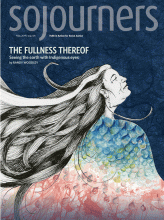THE BOOK OF REVELATION is one of our companions this Eastertide. We are invited to contemplate its central image, the axis around which everything revolves: “the Lamb at the center of the throne” (7:17).
Is this an image that can engage the imaginations of our contemporaries, especially those unfamiliar with the scriptural symbolism? In 2016, I had my tattooist in New Zealand inscribe on the inside of my right forearm a striking copy of a medieval sculpture, one of the few that survive from the great Abbey of Cluny in France. It depicts the Lamb of God, bearing a cross. The Latin inscription surrounding it means, “As carved here the Lamb of God is small, but how great he is in heaven!”
I hadn’t anticipated that bearing this image on my body would lead to all sorts of intriguing conversations. Curious strangers stop me in checkout lines, bars, the beach, the street, asking, “What does that mean?” I talk about the vulnerability of God’s noncoercive love, and its ultimate power. Nothing can take away the sins of the world except the love that is revealed on the cross and vindicated in the resurrection. “Here is the Lamb of God that takes away the sins of the world!” (John 1:29).
Are these conversations sowing seeds of change? Only God knows. As for ourselves, we are still learning from the scripture’s insistence that the ultimate meaning of the Lamb is only accessible through adoration.
Read the Full Article

